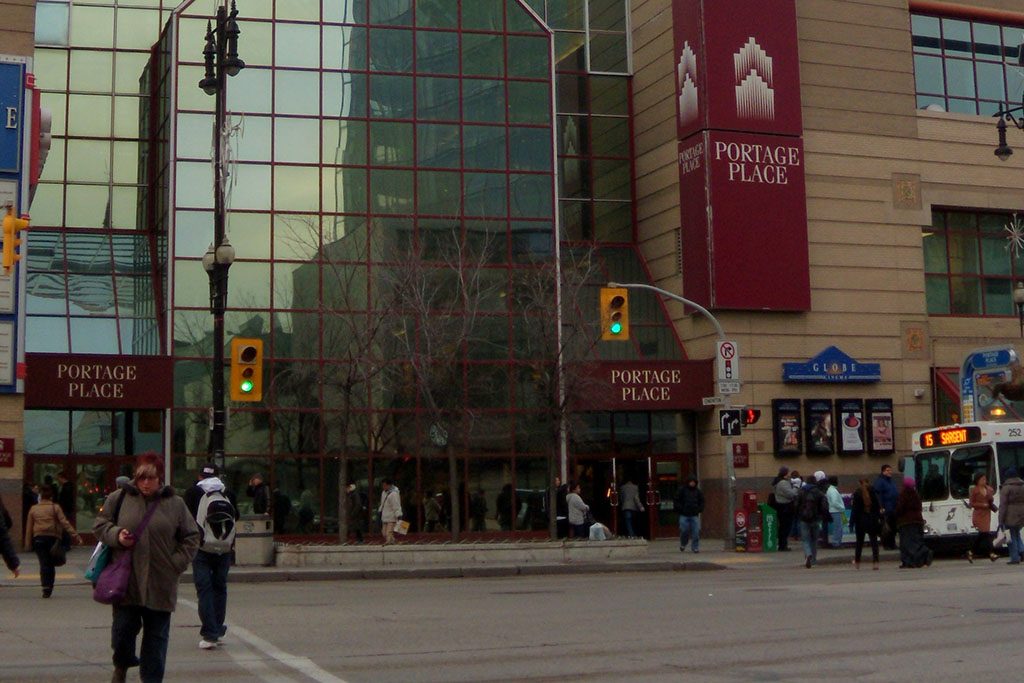Starlight Investments offer to buy the building, land and parking that make up Portage Place mall in downtown Winnipeg has been approved by all levels of government involved in the facility.
The Toronto-based developer offered $22.9 million for the building and $47 million for the land and parking. Published reports indicate that Starlight Investments is now wrapping its review and report on what will happen with the building.
The three-storey, 440,000-square-foot mixed-use shopping centre, located on the north side of Portage Avenue, Winnipeg’s main drag, has been on the market for several years. The ownership structure of Portage Place is complex. The land and parking are owned by North Portage Development Corp., which is owned by the City of Winnipeg, the Province of Manitoba and the federal government.
The mall itself is owned by Vancouver-based Peterson Group.
“To sell all three assets together, the public partnership and the Peterson Group created an informal collaboration and put the assets on the market,” said Clare MacKay, VP, strategic initiatives and executive director, The Forks North Portage Partnership.
Why sell?
“There’s limited opportunity to revitalize Portage Place under the current ownership model, which was created in the 1980s and is stuck there,” said MacKay. “We will trade parking revenue from Portage Place for money from the sale of the assets and invest it in The Forks [a national historic site, market and tourist attraction that gets more than 4 million visits/year].”
Many Portage Place regulars have spoken out against the possible sale.
They say it is proceeding too quickly without knowing whether Starlight will maintain the mall’s function as an informal meeting place.
Starlight has not said what its plans for Portage Place are.
Built more than 30 years ago, the mall was intended to be a destination shopping centre, to encourage suburban shoppers to start coming downtown again.
But the strategy hasn’t worked out as planned. Most shoppers still prefer to go to climate-controlled suburban malls with their acres of free parking.
As a result, many store fronts in Portage Place are vacant, and some retail space has been converted to offices.
Today Portage Place is a gathering place for a diverse population of newcomers, Indigenous people and the homeless.
Businesses have complained about loitering, and there have been confrontations between regulars and security staff.
The mall’s Portage Avenue bus shelter, which was known for drugs and violence, was torn down recently.
The challenges faced by the area go back to the city’s early days, when the massive CPR freight yards separated the poor, foreign North End from the prosperous, Anglo-Canadian South End, says Christopher Adams, adjunct professor of political studies at the University of Manitoba.
“But Manitoba is still a dynamic province, and new Canadians are coming to Winnipeg and finding jobs,” he said.
What to do about Portage Place?
Architect Brent Bellamy (Number Ten Architectural Group) wrote in the Winnipeg Free Press that Portage Place’s limited success has come from its support of the local residential and office populations.
“Future economic success for the building likely means enhancing this support by broadening its target market to include permanent residents of downtown and surrounding neighbourhoods, complemented by, but not primarily focused on, suburban visitors.”
Architect Sasa Radulovic (5468796 Architecture Inc.) says the deterioration of downtown didn’t happen overnight and its rehabilitation won’t happen overnight, either.
“Portage Place is in difficulty at the moment but it has lots of potential, and central Winnipeg is on the upswing,” he said. “The mall is a big site that can be broken into smaller, separate sites that can be redeveloped separately.”
Architect Tom Monteyne (Monteyne Architectural Works Inc.) says
residential towers could be added to the building and the upper floors of the mall converted to offices.
“The mall itself should be maintained as a public space,” Monteyne said. “And perhaps a different retail model, such as small, independent shops like you see in a Middle Eastern bazaar, could be tried.”
Jino Distasio (professor of urban geography, University of Winnipeg) says putting a suburban-style mall in a deteriorating section of Portage Avenue seemed like a good idea in the 1980s, but downtown Winnipeg has changed since then.
“Compared to the 1980s there are more people living and working downtown today, which is a hopeful sign,” said Distasio. “It’s a difficult time for Portage Place now, but it could be viable with a make-over with a mix of uses – light commercial, medical, entertainment and hospitality, some retail and, with caution, some residential.”











Recent Comments
comments for this post are closed